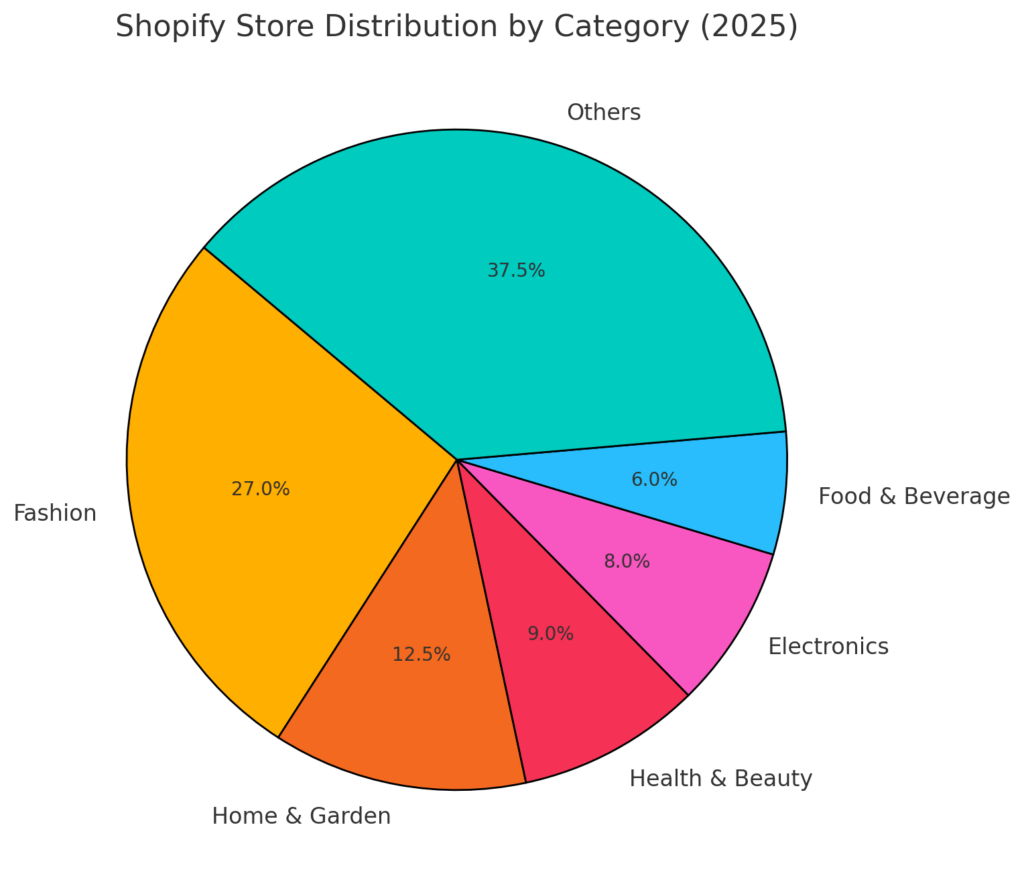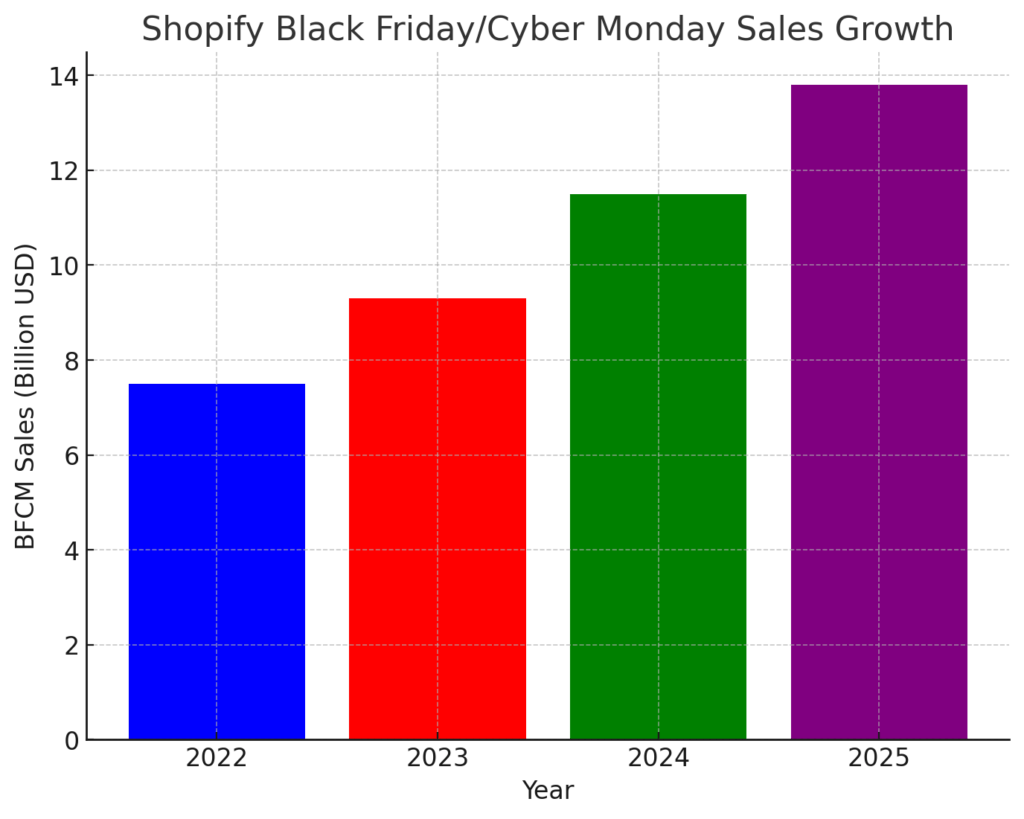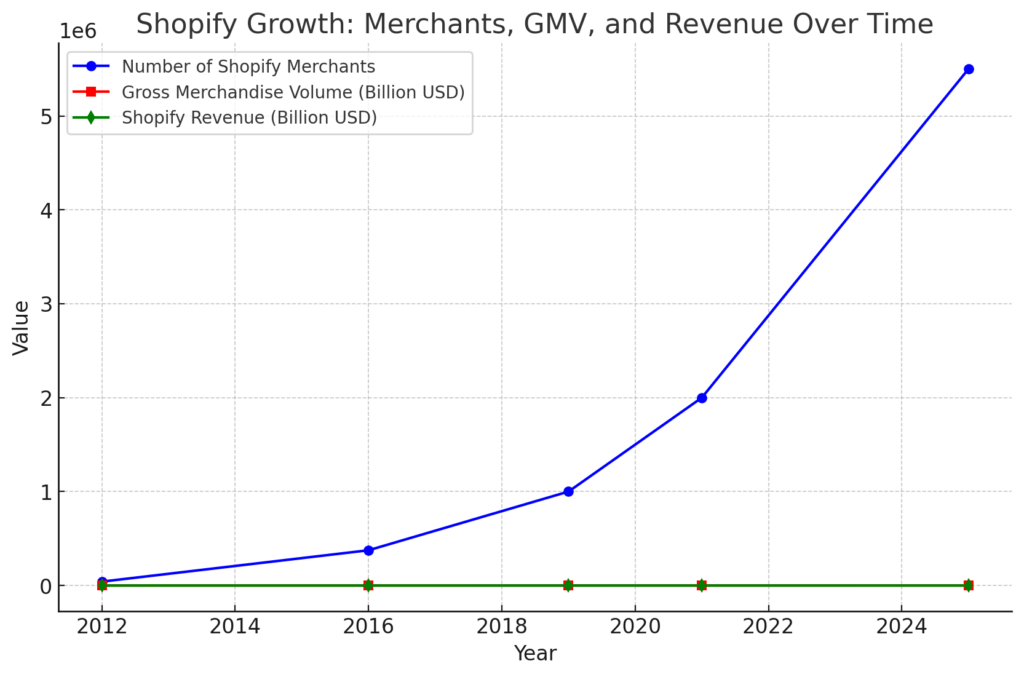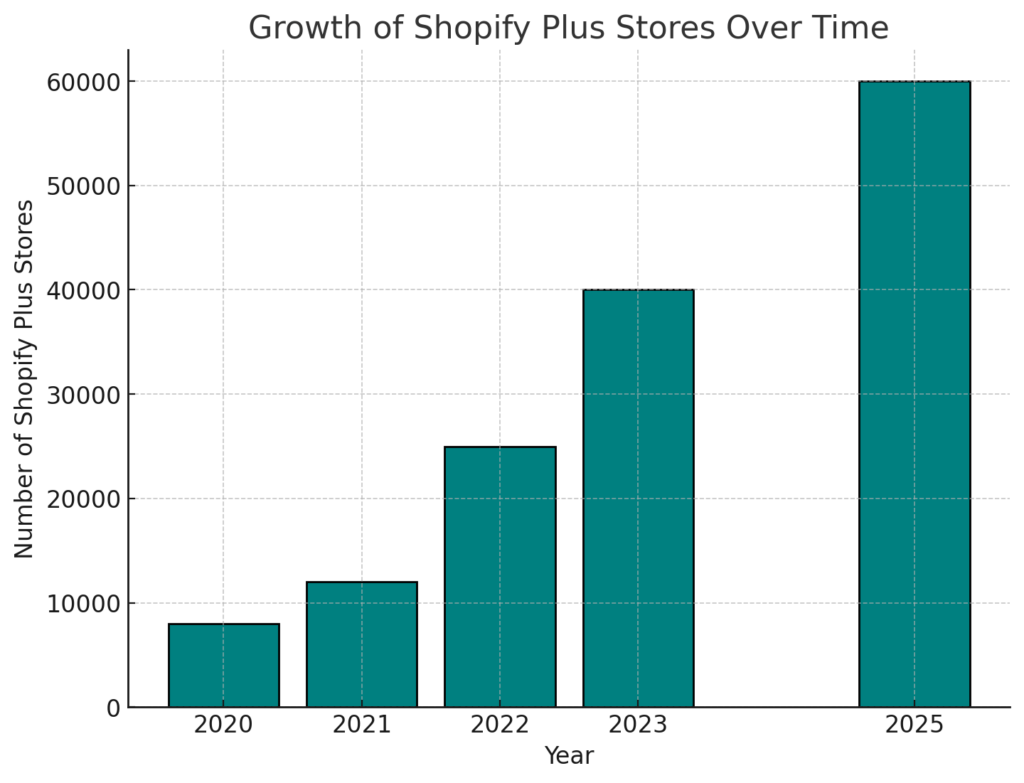
09 Mar TOP SHOPIFY MARKETING STATISTICS 2025
Shopify continues to be a dominant force in e-commerce, empowering millions of merchants worldwide with its user-friendly platform and robust marketing tools. As online shopping evolves, data-driven insights reveal key trends shaping the future of digital retail. From AI-powered automation to the rise of mobile commerce, Shopify’s influence extends far beyond individual stores, impacting the entire e-commerce landscape. Businesses leveraging Shopify’s ecosystem are experiencing higher conversion rates, improved customer retention, and increased revenue through innovative marketing strategies. Understanding the latest Shopify statistics provides valuable insights into where e-commerce is heading in 2025 and beyond. Amra and Elma explores 20 key Shopify marketing statistics, analyzing their significance and potential implications for merchants looking to stay ahead in an increasingly competitive market.
TOP SHOPIFY MARKETING STATISTICS 2025 (Editor’s Choice)
Here are 20 key Shopify marketing statistics, reflecting both historical trends and projections for 2025:
1. Global Reach: As of 2025, Shopify supports over 2.49 million merchants across 175 countries, demonstrating its global appeal and versatility.
2. Merchant Growth: The number of Shopify stores increased by approximately 20% in 2024, indicating a robust growth trajectory leading into 2025.
3. Economic Impact: Shopify has contributed to $444 billion in global economic activity, underscoring its significant role in the e-commerce ecosystem.
4. Black Friday/Cyber Monday Sales: In 2024, Shopify merchants achieved a record $11.5 billion in sales during the Black Friday-Cyber Monday weekend, a 24% increase from the previous year.
5. Mobile Shopping: During the Black Friday-Cyber Monday weekend in 2022, 69% of online sales through Shopify merchants were made via mobile devices, highlighting the importance of mobile optimization.
6. Returning Customer Rate: Shopify stores have an average returning customer rate of 27%, emphasizing the platform’s ability to foster customer loyalty.
7. Email Marketing Conversion: Email marketing boasts a 4.29% conversion rate for Shopify stores, outperforming other marketing channels like search (3.04%) and social media (1.81%).
8. Shopify Plus Adoption: As of 2023, there are nearly 50,000 Shopify Plus stores currently live on the platform, catering to enterprise-level businesses seeking advanced features.
9. App Ecosystem: The Shopify App Store contains over 13,000 apps, allowing merchants to customize and enhance their online stores with various functionalities.
10. Shop Pay Usage: Shopify’s accelerated checkout solution, Shop Pay, is used by around 2 million websites globally, streamlining the purchasing process for customers.
11. Influencer Marketing Growth: The influencer marketing industry is projected to reach $24 billion by the end of 2024, with 50% of marketers utilizing influencers to promote products.
12. Affiliate Marketing Expansion: The global affiliate marketing industry is expected to grow at a compound annual growth rate (CAGR) of 18.86% between 2023 and 2032, reaching nearly $40 billion by the end of the forecast period.
13. Video Marketing Adoption: In 2024, 78% of businesses planned to increase their video marketing efforts, recognizing the medium’s effectiveness in engaging customers.
14. Video Content ROI: 41% of marketers report a high return on investment from video marketing, with product videos yielding the strongest results.
15. Email Marketing ROI: Email marketing campaigns have an average return on investment (ROI) of 36 times, meaning that businesses earn $36 for every dollar spent on email marketing.
16. Social Media Integration: Approximately 48.7% of Shopify stores integrate Instagram, and 31.7% utilize Facebook, leveraging these platforms for marketing and customer engagement.
17. Mobile Traffic: In 2024, 30.4% of visitors to Shopify.com accessed the site via mobile devices, highlighting the growing trend of mobile commerce.
18. Global E-commerce Sales: Global e-commerce sales are estimated to have risen 8.4% to $6.091 trillion in 2024, with Shopify’s revenue expected to have climbed 24.6% during the same period.
19. AI Integration: Shopify’s AI suite, “Shopify Magic,” is reshaping the e-commerce landscape by equipping small businesses with automation tools once exclusive to retail giants.
20. Market Share: Shopify holds a 10.32% global market share in the e-commerce platform market as of 2025. In the United States, its market share is significantly higher at 29%, making it one of the leading e-commerce platforms in the country.
These statistics underscore Shopify’s significant impact on the e-commerce landscape, highlighting its growth, the effectiveness of various marketing strategies, and the platform’s adaptability to emerging trends.

TOP SHOPIFY MARKETING STATISTICS 2025 and Future Implications
TOP SHOPIFY MARKETING STATISTICS 2025 #1. Global Reach:
Shopify’s presence in over 175 countries with 2.49 million merchants in 2025 highlights its global influence in e-commerce. This widespread adoption shows that businesses of all sizes are gravitating toward user-friendly platforms that simplify selling online. As Shopify continues expanding, its ability to cater to diverse markets will be key in staying competitive. The platform’s localized payment gateways and language support have contributed to its international success, ensuring seamless transactions across borders. Future growth will likely depend on further localization efforts, AI-driven automation, and deeper integrations with region-specific logistics solutions. Additionally, emerging markets could drive the next wave of Shopify adoption, particularly in Southeast Asia and Latin America, where digital commerce is booming. Expanding its infrastructure in these regions will be crucial for maintaining its growth trajectory.
TOP SHOPIFY MARKETING STATISTICS 2025 #2. Merchant Growth:
A 20% increase in Shopify stores in 2024 indicates a rising trend in entrepreneurship and digital storefront adoption. Small businesses and independent sellers are increasingly choosing Shopify over traditional retail models, signaling a shift in how commerce operates. This growth also means higher competition among merchants, making advanced marketing strategies and brand differentiation more critical than ever. Shopify’s tools, including AI-powered recommendations and automation, are becoming essential for businesses looking to scale efficiently. Looking ahead, Shopify may need to introduce more sophisticated data analytics and personalized marketing solutions to help merchants stand out. As competition intensifies, we might also see a rise in niche marketplaces built on Shopify, catering to specific industries or demographics. The platform’s ability to support these emerging trends will determine its continued dominance.
TOP SHOPIFY MARKETING STATISTICS 2025 #3. Economic Impact:
Shopify’s $444 billion contribution to global economic activity highlights its significant role in enabling digital entrepreneurship. This figure underscores how the platform empowers small and medium-sized businesses (SMBs) by providing them with a robust, scalable infrastructure. As more entrepreneurs turn to Shopify, traditional retail faces increasing pressure to evolve and integrate digital sales strategies. The platform’s influence on job creation, from e-commerce managers to digital marketing specialists, further strengthens its economic relevance. Moving forward, Shopify’s ability to innovate with AI-driven automation, cross-border selling tools, and financial solutions will define its future impact. Regulatory challenges and taxation policies could become key concerns as governments seek to capture revenues from booming online businesses. If Shopify continues to enhance its ecosystem, it could position itself as the leading hub for digital commerce worldwide.
TOP SHOPIFY MARKETING STATISTICS 2025 #4. Black Friday/Cyber Monday Sales:
The record $11.5 billion in sales during the 2024 Black Friday-Cyber Monday weekend showcases the increasing dominance of online shopping. This 24% growth compared to the previous year suggests that consumers are embracing e-commerce at an unprecedented pace. One driving factor is the convenience of mobile and one-click checkout options, which reduce cart abandonment rates. Retailers leveraging personalized marketing, flash sales, and AI-driven product recommendations saw significant revenue spikes. As Shopify merchants continue to break records, brands that fail to optimize their digital storefronts may struggle to compete. In the coming years, we can expect Shopify to introduce even more AI-powered features to enhance conversion rates during peak shopping seasons. Additionally, sustainability concerns may shape future sales events, with brands emphasizing eco-friendly shipping and ethical production.
TOP SHOPIFY MARKETING STATISTICS 2025 #5. Mobile Shopping:
With 69% of Shopify’s Black Friday-Cyber Monday sales in 2022 coming from mobile devices, the importance of mobile-first e-commerce strategies cannot be overstated. Consumers now expect seamless, fast-loading, and highly intuitive mobile shopping experiences. Merchants who fail to optimize for mobile risk losing significant revenue, especially as younger demographics prioritize mobile browsing. Shopify’s mobile app ecosystem and one-tap checkout features have contributed to these strong mobile sales figures. Looking ahead, the integration of augmented reality (AR) for virtual try-ons and AI-powered mobile shopping assistants could further enhance the user experience. Mobile payment adoption is also expected to rise, making secure and frictionless transactions a priority for Shopify. As mobile commerce continues to grow, merchants must refine their mobile strategies to stay competitive in an increasingly digital-first world.

TOP SHOPIFY MARKETING STATISTICS 2025 #6. Returning Customer Rate:
A 27% returning customer rate for Shopify stores highlights the importance of brand loyalty in sustaining long-term revenue. Customers who return to a store are more likely to spend more, engage with personalized promotions, and become brand advocates. Effective loyalty programs, subscription models, and personalized email campaigns play a critical role in boosting repeat purchases. Shopify merchants leveraging AI-driven segmentation can increase engagement by offering customized product recommendations. Looking forward, retention strategies will become even more sophisticated, with AI automating hyper-personalized shopping experiences. Social commerce, particularly through platforms like Instagram and TikTok, will also drive more direct-to-consumer (DTC) brand engagement. As competition grows, businesses that focus on customer lifetime value rather than one-time purchases will see sustained success.
TOP SHOPIFY MARKETING STATISTICS 2025 #7. Email Marketing Conversion:
Email marketing’s 4.29% conversion rate on Shopify outperforms social media and search, proving its effectiveness in driving direct sales. Unlike social ads, which are subject to platform algorithm changes, email gives brands full control over their messaging. Personalized email campaigns with dynamic content, cart recovery reminders, and limited-time offers significantly improve conversion rates. Automation tools powered by AI are making email marketing more effective, allowing for precise segmentation based on user behavior. As Shopify merchants refine their email strategies, we can expect even higher conversion rates through predictive analytics and real-time personalization. Integrations with SMS marketing and chatbot-driven interactions will further enhance the effectiveness of email-driven campaigns. Looking ahead, merchants who fail to capitalize on owned media channels like email risk over-reliance on paid advertising, which is becoming more expensive.
TOP SHOPIFY MARKETING STATISTICS 2025 #8. Shopify Plus Adoption:
Shopify Plus stores nearing 50,000 in 2023 demonstrate the growing demand for enterprise-level e-commerce solutions. Larger brands are recognizing Shopify’s ability to scale, providing advanced automation, lower transaction fees, and dedicated support. Unlike legacy e-commerce platforms, Shopify Plus offers flexibility and ease of use, making it an attractive option for high-growth businesses. The rise of direct-to-consumer (DTC) brands has also fueled Shopify Plus adoption, as companies seek greater control over their customer relationships. Looking forward, Shopify Plus could introduce AI-driven merchandising, enhanced multi-store capabilities, and deeper integrations with global fulfillment networks. The platform’s ability to support rapid international expansion will be critical for retaining large merchants. As enterprise e-commerce competition intensifies, Shopify’s continuous innovation will determine its ability to maintain its stronghold in this market segment.
TOP SHOPIFY MARKETING STATISTICS 2025 #9. App Ecosystem:
With over 13,000 apps available in the Shopify App Store, merchants have an extensive range of tools to enhance their stores. These apps cover various functions, from inventory management to AI-driven marketing, providing businesses with greater flexibility. As Shopify’s ecosystem expands, third-party developers will continue to play a critical role in driving innovation. Future trends could include more AI-powered automation apps that help merchants optimize pricing, personalize marketing, and improve customer service. The rise of headless commerce—where businesses separate the front-end and back-end of their stores—could lead to increased demand for modular app integrations. Shopify’s ability to maintain a high-quality app marketplace while preventing excessive app dependency will shape its future. Merchants who strategically leverage the right mix of apps will have a competitive advantage in automation and customer experience.
TOP SHOPIFY MARKETING STATISTICS 2025 #10. Shop Pay Usage:
Shop Pay’s adoption by 2 million websites globally demonstrates its effectiveness in streamlining checkout processes. Faster checkouts reduce cart abandonment, making transactions more seamless for customers. With built-in security and pre-saved customer details, Shop Pay enhances convenience, particularly for mobile users. As payment methods evolve, we could see Shop Pay integrating with more blockchain-based solutions and digital wallets. The growing demand for frictionless payment experiences suggests Shopify will continue refining its payment ecosystem with AI-driven fraud detection and personalized financing options. Subscription-based businesses could also benefit from enhanced recurring payment solutions integrated with Shop Pay. As online payment security becomes a greater concern, Shopify’s continued investment in encrypted and decentralized payment technologies will be essential.

TOP SHOPIFY MARKETING STATISTICS 2025 #11. Influencer Marketing Growth:
With the influencer marketing industry expected to hit $24 billion by 2024, Shopify merchants are increasingly turning to creators to drive sales. Influencers help brands build trust and engagement by providing authentic product recommendations. Shopify’s seamless integration with social media platforms makes it easier for brands to track influencer-driven conversions. AI-powered influencer discovery tools will likely become more popular, helping brands identify creators with the highest ROI. Future advancements in social commerce, such as live-stream shopping, could further enhance influencer-driven sales. However, brands must balance authenticity with paid promotions, as consumers become more skeptical of overt sponsorships. The success of influencer marketing will depend on maintaining genuine connections with audiences while leveraging data-driven targeting.
TOP SHOPIFY MARKETING STATISTICS 2025 #12. Affiliate Marketing Expansion:
Affiliate marketing’s projected 18.86% CAGR suggests that more Shopify merchants are embracing performance-based partnerships. Unlike traditional advertising, affiliate marketing allows brands to pay only for successful conversions, making it a cost-effective strategy. Shopify’s integration with affiliate marketing platforms simplifies tracking and commission payouts, encouraging more merchants to adopt this model. The rise of micro-affiliates—small content creators and bloggers with niche audiences—will likely shape the future of affiliate marketing. AI-driven attribution models could further refine how commissions are distributed, ensuring accurate tracking of multi-touchpoint conversions. As competition increases, brands will need to offer attractive commission structures to retain high-performing affiliates. Shopify’s ability to innovate in affiliate management tools will determine its effectiveness in helping merchants scale this revenue stream.
TOP SHOPIFY MARKETING STATISTICS 2025 #13. Video Marketing Adoption:
With 78% of businesses planning to increase video marketing efforts in 2024, Shopify merchants must prioritize visual storytelling. Short-form videos, product demos, and user-generated content have proven to drive higher engagement and conversion rates. Shopify’s integration with video-based platforms like TikTok and YouTube enables brands to connect directly with customers. AI-driven video editing tools and personalized video recommendations could enhance e-commerce marketing strategies. As platforms shift toward interactive video content, Shopify merchants may explore shoppable video ads and live-stream sales events. Brands that fail to invest in video marketing risk losing visibility as algorithms increasingly favor video content. Moving forward, Shopify will likely expand its video marketing tools to help merchants create and distribute compelling content more effectively.
TOP SHOPIFY MARKETING STATISTICS 2025 #14. Video Content ROI:
With 41% of marketers reporting a high return on investment from video marketing, Shopify merchants should consider prioritizing video content. Product demonstrations, behind-the-scenes content, and testimonials help build trust and drive conversions. Shopify’s ability to integrate with video hosting platforms like Vimeo and Wistia allows brands to embed high-quality videos in their stores. AI-powered video personalization, where customers receive customized video recommendations, could become a game-changer. As 5G technology expands, faster streaming capabilities will make video-heavy e-commerce experiences more seamless. Brands investing in interactive videos, such as “choose your own adventure” shopping experiences, may see higher engagement rates. Shopify merchants who fail to incorporate video marketing risk falling behind competitors that leverage dynamic content effectively.
TOP SHOPIFY MARKETING STATISTICS 2025 #15. Email Marketing ROI:
With an average return of $36 for every $1 spent, email marketing remains a powerhouse for Shopify merchants. Unlike paid ads, email marketing allows businesses to nurture long-term customer relationships without reliance on third-party platforms. AI-driven automation tools enable hyper-personalized email sequences based on browsing behavior, past purchases, and engagement levels. As privacy regulations tighten, brands will need to focus on collecting first-party data through email opt-ins. Interactive emails, such as embedded product previews and checkout buttons, could further enhance engagement. Shopify’s continued investment in AI-powered email solutions will help merchants increase conversion rates with predictive analytics. The brands that refine their email marketing strategies now will future-proof their revenue streams as digital advertising costs rise.

TOP SHOPIFY MARKETING STATISTICS 2025 #16. Social Media Integration:
With 48.7% of Shopify stores integrating Instagram and 31.7% using Facebook, social commerce is becoming essential for e-commerce success. These platforms drive direct traffic to Shopify stores, allowing merchants to leverage influencer marketing and targeted ads effectively. TikTok’s increasing presence in e-commerce suggests that video-driven shopping will play a greater role in the future. Shopify’s social commerce integrations will likely expand, incorporating emerging platforms such as Threads and BeReal. AI-driven social listening tools could help brands track trends and adjust their marketing strategies in real-time. As first-party data becomes more valuable, Shopify merchants will need to build stronger connections with their social media audiences. The future of Shopify’s success will be tied to its ability to stay ahead of evolving social commerce trends.
TOP SHOPIFY MARKETING STATISTICS 2025 #17. Mobile Traffic:
With 30.4% of visitors to Shopify.com accessing the site via mobile devices in 2024, mobile-first design is no longer optional. Mobile shopping behavior continues to rise, requiring merchants to optimize their storefronts for speed, responsiveness, and seamless navigation. Features such as voice search, AI chatbots, and mobile-friendly checkout options are becoming critical. Shopify’s continued investment in mobile performance improvements will determine merchants’ ability to capture more mobile-driven sales. Progressive web apps (PWAs) could offer an alternative to traditional mobile apps, providing a fast, app-like experience without requiring downloads. As mobile commerce expands, Shopify merchants who fail to prioritize mobile optimization may lose customers to competitors with frictionless experiences. Future advancements in 5G and augmented reality shopping will further redefine mobile e-commerce interactions.
TOP SHOPIFY MARKETING STATISTICS 2025 #18. Global E-commerce Sales:
With global e-commerce sales projected to reach $6.091 trillion in 2024, Shopify’s 24.6% revenue growth reflects its strong position in the market. The rise of digital-first brands and direct-to-consumer models has fueled Shopify’s expansion. AI-driven personalization, subscription-based shopping, and one-click checkout innovations will shape the next wave of e-commerce growth. Shopify’s success will depend on its ability to support cross-border transactions with localized payment and fulfillment options. As more brands seek to reach international audiences, Shopify may need to enhance multilingual support and regional marketing tools. Regulatory challenges, including data privacy laws and tax compliance, will also play a role in shaping Shopify’s global strategy. Merchants that capitalize on these trends will have an edge in the increasingly competitive e-commerce landscape.
TOP SHOPIFY MARKETING STATISTICS 2025 #19. AI Integration:
Shopify’s AI suite, Shopify Magic, is transforming e-commerce by providing automation tools that were previously exclusive to major retailers. AI-driven product descriptions, chatbots, and predictive analytics are helping merchants optimize their operations. Personalized shopping experiences powered by AI increase customer engagement and conversion rates by tailoring recommendations to individual preferences. As AI technology advances, we may see more real-time dynamic pricing, automated inventory forecasting, and hyper-personalized email marketing campaigns. Shopify’s AI capabilities could also enhance fraud detection, ensuring secure transactions for both merchants and customers. Looking ahead, the ability to integrate AI into every aspect of an online store will become a competitive necessity. Merchants who fail to embrace AI-driven tools may struggle to keep pace with evolving consumer expectations and industry trends.
TOP SHOPIFY MARKETING STATISTICS 2025 #20. Market Share:
Shopify’s 10.32% global market share in e-commerce platforms—and 29% in the U.S.—solidifies its dominance in the industry. This strong position indicates that Shopify continues to be a top choice for businesses of all sizes, from small startups to major brands. Its ease of use, extensive app marketplace, and scalability contribute to its popularity, allowing merchants to launch and grow their stores efficiently. However, competitors like WooCommerce, BigCommerce, and Wix are constantly innovating, challenging Shopify’s market leadership. To maintain its dominance, Shopify must continue enhancing its features, particularly in areas like AI, omnichannel selling, and mobile commerce. As more merchants look to expand globally, Shopify’s ability to streamline international selling will be a key factor in its long-term success. With e-commerce continually evolving, Shopify’s adaptability and innovation will determine whether it can sustain its market leadership in the coming years.
The Future of Shopify and E-Commerce in 2025 and Beyond
Shopify’s continued growth and evolving ecosystem underscore its role as a leader in the digital commerce space. As mobile shopping, AI-driven personalization, and influencer marketing gain momentum, merchants who adapt to these trends will position themselves for long-term success. The platform’s expanding capabilities, including advanced analytics, automation, and seamless social commerce integrations, provide businesses with the tools needed to stay competitive. However, rising competition from other e-commerce platforms and the increasing complexity of global online retail present new challenges. Merchants who prioritize customer experience, leverage AI for efficiency, and embrace omnichannel strategies will thrive in the changing landscape. Looking ahead, Shopify’s ability to innovate and provide cutting-edge solutions will determine its influence in the next phase of e-commerce. Businesses that harness these insights and optimize their marketing strategies will be best equipped to capitalize on the platform’s growth and opportunities in 2025 and beyond.
Sources:
- https://enricher.io/blog/shopify-statistics
- https://www.chargeflow.io/blog/shopify-statistics
- https://www.webfx.com/blog/marketing/shopify-statistics
- https://www.charleagency.com/articles/shopify-statistics
- https://thesocialshepherd.com/blog/shopify-statistics
- https://thesocialshepherd.com/blog/shopify-statistics
- https://thesocialshepherd.com/blog/shopify-statistics
- https://www.webfx.com/blog/marketing/shopify-statistics
- https://thesocialshepherd.com/blog/shopify-statistics
- https://www.digitalsilk.com/digital-trends/top-shopify-statistics
- https://www.shopify.com/blog/influencer-marketing-statistics
- https://www.shopify.com/hk-en/blog/affiliate-marketing-statistics
- https://www.shopify.com/blog/video-marketing-statistics
- https://www.shopify.com/blog/video-marketing-statistics
- https://www.shopify.com/blog/email-marketing-statistics
- https://storeleads.app/reports/shopify
- https://redstagfulfillment.com/shopify-statistics
- https://www.reuters.com/technology/artificial-intelligence/how-canadas-shopify-is-weaving-ai-magic-pull-merchants-2025-02-10
- https://www.reuters.com/technology/artificial-intelligence/how-canadas-shopify-is-weaving-ai-magic-pull-merchants-2025-02-10
- https://enricher.io/blog/shopify-statistics

